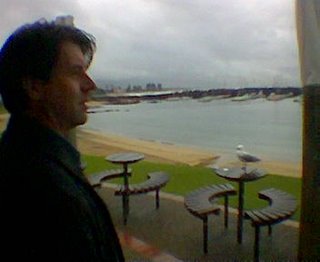A bit about the Blue Mountains.

This is why they are called the Blue Mountains.
OK, here's a few things about the Blue Mountains that don't usually make the regular pages.
1: It was a fairly fertile ground here for local aboriginals, lots of water, lots of food. A guy I've met from up around the village of Lawson, who is into things spiritual and esoteric , tells me that aboriginals legends mention there being a lot of "serpent energy" around this place. This means trials and tribulations in some instances bust-ups and it seems only a certain type of person lives here. Dunno, most people here seem pretty ordinary. Nevertheless I've been on the "other"(northern) side of Lawson and felt a very strange energy there. I don't believe in these things, but there seems to be something about the place.
2: Another aboriginal story involves the aboriginals steering clear of the Grose Valley region. They detoured right around it. Could have something to do with the reports of Yowies (like a sasquatch) in that area.
3: The Woodford Academy is said to be haunted. Groundmen aren't usually employed there for very long due to "something pushing them off their feet". Freaks them out pretty quickly. Haven't checked this one lately, so will keep an eye on the local employment pages.
4: The road and railway track winds along the ridge of the Blue Mountains ranges, offering some spectacular views along the way. Explorers in old times tried exploring via the rivers, coming to cliffs and waterfalls, then the ridge way was tried with some success.
5: The town of Faulconbridge, near where I live is described as "the most equitable climate in the world" by the World Meteoroligical Organization.
Criteria include:
- Mild temperature range
- Rainfall evenly distributed throughout the year
- High percentage of oxygen in the air
- Mild humidity range
6: The town of Medlow Bath with the gorgeous Hydro Majestic Hotel was once a haven for Europeans and British seeking out mineral baths for health reasons in the early 20th century. The Europeans also headed mountainward during the hot summer months to cool off. In winter they headed up to experience "real winter" including snow.
7: Yulefest is held in June/July/August up here, Australians enjoying Christmas dinners, sometimes with snow. Apparently, this was started by some Irish.
8: I live on the side of a ridge overlooking an extinct volcano at Sun Valley described by one conservationist thus:
"Sun Valley it is the role of the volcanic diatreme, which is a neck of an extinct volcano, which has produced a deep rich soil supporting the tall Sun Valley Cabbage Gum Forests in the Sun Valley Reserve."
9: A "dinosaur tree" was discovered in Wollemi Park which is part of the Blue Mountains World Heritage Area.
‘Dinosaur tree’ or ‘living fossil’, the Wollemi Pine is certainly one of the greatest botanical discoveries of our time.
In September 1994 David Noble, an officer with the NSW National Parks & Wildlife Service, discovered some trees he didn’t quite recognise. In a deep, narrow canyon of the rugged Wollemi National Park, he discovered what we now call Wollemia nobilis or the Wollemi Pine.
The dramatic discovery of an evolutionary line thought to be long extinct is even more remarkable with these tall and striking trees growing only 150 km from Sydney, the largest city in Australia. They were found in the extremely rugged Wollemi National Park, a largely undisturbed wilderness area.



2 Comments:
Wow, a great mix of old world and new. Now you must stop or I may get on a freighter and come down. On second thought, seeing that cable car makes me a bit wobbly (I don't like heights).
I once was hired to compose some music for a US "Australian" movie named The Shrimp On The Barbie (a title that well might not mean anything to an Australian, derived from an Aussie tourism capaign with that Hogan guy). As the producer was a regular bad-guy producer, I quit (following the director's example, this was an Alan Smithee film). They negotiated with my lawyer to buy about fifteen minutes of the music I had composed, to use in the film anyway.
By Peter (the other), at 1:52 am
Peter (the other), at 1:52 am
Shrimps are known as prawns down here, shrimp are like really tiny baby prawns.
Just had a look at that film on IMDB, looks as if you made a wise choice!!!
By Johnno, at 10:53 pm
Johnno, at 10:53 pm
Post a Comment
<< Home